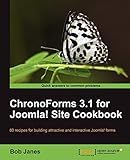Best Joomla Installation Tools to Buy in December 2025

Joomla! A User's Guide: Building a Successful Joomla! Powered Website



Joomla! Explained: Your StepbyStep Guide (Joomla! Press)



ChronoForms 3.1 for Joomla! Site Cookbook



Blogging with Joomla: Everything you ever wanted to know about building a blog with Joomla



Joomla! 4 - Guida completa (Italian Edition)


To install Joomla in cPanel, you need to follow these steps:
- Download Joomla: Visit the official Joomla website (joomla.org) and download the latest stable release of Joomla. Save the downloaded file on your computer.
- Login to cPanel: Open your cPanel account by visiting www.yourdomain.com/cpanel and enter your username and password.
- Navigate to File Manager: In cPanel, locate the "File Manager" icon and click on it. This will open the file management interface.
- Upload Joomla files: In the File Manager, click on "public_html" or the folder where you want to install Joomla. Then click on the "Upload" button and select the Joomla zip file you downloaded earlier. Wait for the file to upload and then extract it.
- Create a new database: Go back to the cPanel main page and find the "MySQL Databases" icon. Click on it and create a new database by entering a name and clicking "Create Database". Also, create a new database user and assign it to the database, remembering the username and password.
- Run the Joomla installation: Open your web browser and visit your website URL. The Joomla installation screen will appear. Select the language and click "Next". Review and accept the terms of the Joomla license agreement and proceed.
- Enter database details: On the next page, enter the database details such as database type, host, name, username, and password. You can usually leave the database type as "MySQLi" and the host as "localhost". Enter the database name, username, and password you created in step 5, and click "Next".
- Setup FTP details (optional): If you want to enable FTP so that Joomla can install extensions and templates directly, provide the FTP details on the following page, or you can skip this step.
- Configure website settings: On the next screen, enter the site name, description, admin email, username, and password. Make sure to choose a strong password. Click "Next" when finished.
- Remove installation folder: After the installation is complete, Joomla will prompt you to remove the installation folder for security purposes. Click the "Remove installation folder" button, and Joomla will automatically delete the installation files.
- Access your Joomla site: Joomla is now installed. You can access the front-end of your website by visiting your domain name. To access the back-end administration panel, add "/administrator" to the end of your domain URL (e.g., www.yourdomain.com/administrator) and enter the admin username and password you created earlier.
That's it! You have successfully installed Joomla in cPanel. You can now customize your website, install templates, and add content using the Joomla administration panel.
How do I access cPanel on my hosting account?
To access cPanel on your hosting account, you can follow these steps:
- Open your preferred web browser.
- Type your domain name followed by "/cpanel" (e.g., "www.yourdomain.com/cpanel") in the browser's address bar.
- Press Enter, and you will be redirected to the cPanel login page.
- Enter your cPanel username and password in the appropriate fields.
- Click on the "Log in" or "Sign in" button to access your cPanel account.
If you don't know your cPanel username and password, you can find them in the welcome email from your hosting provider. Alternatively, you can contact your hosting provider's support team for assistance in retrieving or resetting your login credentials.
How can I check if my hosting provider supports Joomla?
There are a few ways you can check if your hosting provider supports Joomla:
- Check the hosting provider's website or documentation: Many hosting providers will explicitly state that they support Joomla on their website or in their documentation. Look for information about CMS compatibility or supported software.
- Contact the hosting provider's support team: If you can't find the information on their website, reach out to their support team. They will be able to confirm whether or not Joomla is supported on their servers.
- Look for Joomla-specific hosting packages: Some hosting providers offer specialized hosting packages specifically for Joomla. These packages often come pre-configured with Joomla and may include additional features and support for the CMS.
- Check online forums and communities: If you're unable to find information directly from the hosting provider, you can search online forums and communities dedicated to Joomla or web hosting. Other users may have already asked about the compatibility with specific hosting providers, and you might find relevant information or recommendations.
Remember that simply supporting Joomla may not be enough. You should also consider other factors such as server performance, uptime, customer support, and pricing when choosing a hosting provider for your Joomla website.
What is cPanel and why do I need it for Joomla installation?
cPanel is a web hosting control panel that provides a graphical interface for managing websites and server settings. It simplifies various administrative tasks such as website creation, database management, email account setup, and file management. Additionally, it offers features like backups, security, and domain management.
You need cPanel for Joomla installation because it allows you to easily manage the server environment required by Joomla. It provides tools like a file manager to upload Joomla files, a database management system (such as phpMyAdmin) to create and manage the Joomla database, and an interface to configure necessary server settings like PHP version and extensions. cPanel streamlines and simplifies the process, making it accessible to users without extensive technical knowledge.
How to create a new subdomain for Joomla in cPanel?
To create a new subdomain for Joomla in cPanel, follow these steps:
- Log in to your cPanel account.
- Scroll down to the Domains section and click on Subdomains.
- In the Subdomain field, enter the name for your subdomain (e.g., "blog" for blog.domain.com).
- Choose the main domain on which you want to create the subdomain from the dropdown menu.
- The Document Root field will be automatically populated based on your subdomain name and main domain. You can adjust it if necessary.
- Click on the Create button to create the subdomain.
Once the subdomain is created, you can proceed with installing Joomla on it:
- Download the latest Joomla installation package from the official Joomla website.
- Extract the downloaded package on your computer.
- Connect to your website's server using an FTP client.
- Upload all the Joomla files to the Document Root folder of your subdomain on the server.
- Create a new MySQL database for Joomla in cPanel.
- Run the Joomla installation by accessing your subdomain URL in a web browser.
- Follow the on-screen instructions to complete the Joomla installation process.
After the installation is complete, you will have a functioning Joomla website on your newly created subdomain.
How to set up a MySQL user and grant privileges for Joomla installation?
To set up a MySQL user and grant privileges for Joomla installation, follow these steps:
- Access your MySQL server either through the command-line interface or a tool like phpMyAdmin.
- Create a new database for Joomla installation by running the following command: CREATE DATABASE joomla_database; Replace "joomla_database" with your preferred database name.
- Create a new MySQL user by running the following command: CREATE USER 'joomla_user'@'localhost' IDENTIFIED BY 'password'; Replace "joomla_user" with your preferred username, and "password" with a strong password for the user.
- Grant all privileges on the Joomla database to the MySQL user: GRANT ALL PRIVILEGES ON joomla_database.* TO 'joomla_user'@'localhost'; Replace "joomla_database" with your database name and "joomla_user" with your MySQL username.
- Flush the privileges to update the changes: FLUSH PRIVILEGES;
- Your MySQL user should now have the necessary privileges for the Joomla installation. You can proceed with the Joomla setup and provide the MySQL database details during the installation process.
